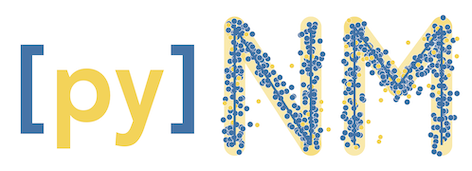Lightweight Python implementation of Normative Modelling with Gaussian Processes, LOESS & Centiles approaches.
For a more advanced implementation, see the Python librairie PCNtoolkit.
To install pynm:
$ pip install pynm
Alternatively, for development purposes, clone this repository and run:
$ git clone https://github.com/ppsp-team/PyNM
$ cd PyNM
$ python setup.py develop
All code for PyNM is written in Python (Python>=3.5). See requirements.txt for a full list of dependencies.
usage: pynm [-h] --pheno_p PHENO_P --out_p OUT_P [--confounds CONFOUNDS]
[--conf CONF] [--score SCORE] [--group GROUP] [--method METHOD]
[--num_epochs NUM_EPOCHS] [--n_inducing N_INDUCING]
[--batch_size BATCH_SIZE] [--length_scale LENGTH_SCALE] [--nu NU]
optional arguments:
-h, --help show this help message and exit
--pheno_p PHENO_P Path to phenotype data. Data must be in a .csv file.
--out_p OUT_P Path to output directory.
--confounds CONFOUNDS List of confounds to use in the GP model.The list must
formatted as a string with commas between confounds,
each confound must be a column name from the phenotype
.csv file. Categorical confounds must be denoted by
with C(): e.g. 'C(SEX)' for column name 'SEX'. Default
value is 'age'.
--conf CONF Single numerical confound to use in LOESS & centile
models. Must be a column name from the phenotype .csv
file. Default value is 'age'.
--score SCORE Response variable for all models. Must be a column
title from phenotype .csv file. Default value is 'score'.
--group GROUP Column name from the phenotype .csv file that
distinguishes probands from controls. The column must
be encoded with str labels using 'PROB' for probands
and 'CTR' for controls or with int labels using 1 for
probands and 0 for controls. Default value is 'group'.
--method METHOD Method to use for the GP model. Can be set to
'auto','approx' or 'exact'. In 'auto' mode, the exact
model will be used for datasets smaller than 1000 data
points. SVGP is used for the approximate model.
See documentation for details. Default value is 'auto'.
--num_epochs NUM_EPOCHS Number of training epochs for SVGP model.
See documentation for details. Default value is 20.
--n_inducing N_INDUCING Number of inducing points for SVGP model.
See documentation for details. Default value is 500.
--batch_size BATCH_SIZE Batch size for training and predicting from SVGP
model. See documentation for details. Default value is 256.
--length_scale LENGTH_SCALE Length scale of Matern kernel for exact model.
See documentation for details. Default value is 1.
--nu NU Nu of Matern kernel for exact and SVGP model.
--train_sample TRAIN_SAMPLE On what subset to train the model, can be 'controls',
'manual', or a value in (0,1]. Default value is 'controls'.
All the functions have the classical Python DocStrings that you can summon with help(). You can also see the tutorials for documented examples.
By default, the models are fit on all the controls in the dataset and prediction is then done on the entire dataset. The residuals (scores of the normative model) are then calculated as the difference between the actual value and predicted value for each subject. This paradigm is not meant for situations in which the residuals will then be used in a prediction setting, since any train/test split stratified by proband/control will have information from the training set leaked into the test data.
In order to avoid contaminating the test set, in a prediction setting it is important to fit the normative model on a subset of the controls and then leave those out. This is implemented in PyNM with the --train_sample flag. It can be used in three ways:
- Number in (0,1]
- This is simplest usage that defines the sample size, PyNM will then select a random sample of the controls and use those as a training group.
- The subjects used in the sample are recorded in the column
'train_sample'of the resulting PyNM.data object. Subjects used in the training sample are encoded as 1s, and the rest as 0s.
'manual'- It is also possible to specify exactly which subjects to use as a training group by providing a column in the input data labeled
'train_sample'encoded the same way.
- It is also possible to specify exactly which subjects to use as a training group by providing a column in the input data labeled
'controls'- This is the default setting that will fit the model on all the controls.
Original papers with Gaussian Processes (GP):
- Marquand et al. Biological Psychiatry 2016 (doi:10.1016/j.biopsych.2015.12.023)
- Marquand et al. Molecular Psychiatry 2019 (doi:10.1038/s41380-019-0441-1)
Example of use of the LOESS approach:
- Lefebvre et al. Front. Neurosci. 2018 (doi:10.3389/fnins.2018.00662)
- Maruani et al. Front. Psychiatry 2019 (doi:10.3389/fpsyt.2019.00011)
For the Centiles approach, see Bethlehem et al. Communications Biology 2020 (doi:10.1038/s42003-020-01212-9) with the R implementation here.
If you spot any bugs 🪲? Check out the open issues to see if we're already working on it. If not, open up a new issue and we will check it out when we can!
Thank you for considering contributing to our project! Before getting involved, please review our contribution guidelines.
This work is supported by Compute Canada, IVADO, and FRQS.


